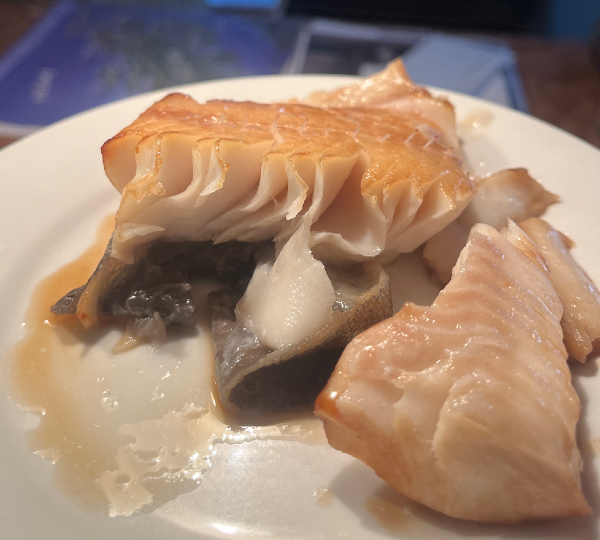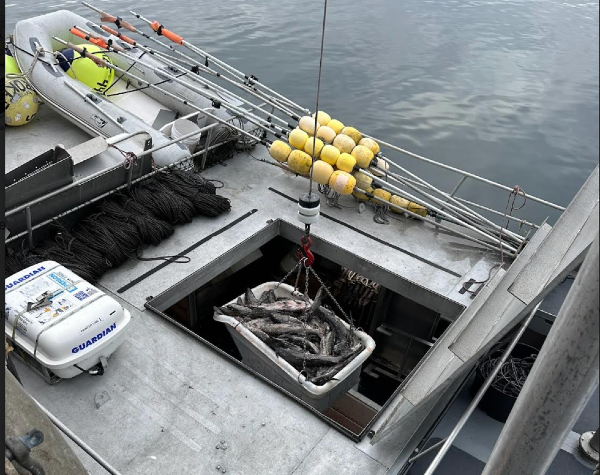A public serv-fish announcement: You should be eating more black cod.
Alaska caught black cod is oily and delicious, and it's selling at rock bottom prices right now in part because of the devaluation of the Japanese yen.

Northern Journal depends on reader contributions to sustain its coverage. If you've already become a member, thank you; if you haven't, please consider a voluntary membership.
I do not ever attempt to buy or sell individual shares of publicly traded companies — I’m too financially incompetent. Consequently, I would not ever suggest turning to Northern Journal for personal financial advice or stock tips.
However, this is a column wholly dedicated to telling you, quite assuredly, how you can personally profit from the weak Japanese yen, which recently hit its lowest value against the U.S. dollar in decades.
Run, do not walk, to your nearest fish market to buy some black cod — a species that’s being sold for cheap in U.S. markets as its Japanese customer base has eroded.
In due course over the next thousand words, I will provide you with ample scientific background and narrative justification for why you should eat more of this underrated, undervalued denizen of the deepwater Pacific. (If you are a fisherman or fishing community resident whose freezer is already full of black cod, sorry for my patronizing tone; you can skip this column.)
Such is my confidence that I will first make you an aggressive proposal:
If you have never tried black cod before, go and get some. It is selling for $9.99 a pound at Costco in Anchorage, the same as fresh silver salmon.
Bring it home, prepare it in accordance with literally any recipe you can find on the internet.
If you dislike it, send me a Venmo request — @nat-herz — and I will reimburse up to 10 readers’ black cod costs before I begin passing claims along to the Alaska Seafood Marketing Institute. If, however, your black cod initiation results in persistent daydreams involving oily white flakes and miso crusts, you must buy a paid membership to Northern Journal — fair is fair.
Okay, back to this column, which, like a good black cod filet, has been marinating for a while.
Alaska’s seafood industry has been contending with turbulent global markets for the past two years, which have been hammering harvest values and threatening fishermen’s and processing companies’ financial stability.

You probably heard something about how the prices paid to salmon fishermen crashed last summer, prompting boat-borne protests and generating headlines in national news outlets.
But it’s unlikely you heard anything about black cod, which is harvested in smaller volumes — though the numbers are still significant for many full-time Alaska fishermen and processing businesses, with annual catches valued at $100 million a year or more. The per-pound value of last year's harvest in Southeast Alaska, a key region for the fishery, was $2.59 — the lowest price since 1998, according to the Alaska Department of Fish and Game.
Black cod, or Anoplopoma fimbria, are a little bit mysterious — they live a quarter-mile or more below the surface, and federal scientists say they’ve never been observed while spawning. They are not, in fact, in the cod family: The only other member of Anoplopomatidae is the skilfish, another dark-colored species that thrives in cold and deep water.

Black cod are found offshore from California to Japan, and archaeologists have documented more than 2,000 years of Native American dependence on them in the Pacific Northwest. On Haida Gwaii, the archipelago off British Columbia, oral tradition holds that visitors were loath to leave the west coast because they didn’t want to miss out on the abundant fish.
In modern times, the major black cod market has been Japan, whose fishing boats would travel all the way to the waters off Alaska, where the species was most abundant, to harvest. Prices that processors were paying American fishermen were low.
“Nobody really wanted it, because the foreign fleet was catching it themselves,” said Norm Pillen, a veteran Sitka fisherman who now runs a cooperatively owned processing company in the Southeast community.
Things changed in the late 1970s, as Congress extended American fishery management authority from 12 to 200 miles offshore, and the Japanese fishery was eventually evicted.
“That just opened up the market,” Pillen said.

Alaska fishermen have traditionally harvested black cod largely using miles-long lines that sit on the ocean floor with thousands of individually baited hooks. Now, they’re increasingly using large pots, to keep orcas from stealing their catch.
It’s a grueling and expensive fishery, as boats often must drive far offshore to the deep waters where black cod live, Pillen said.
Much of Alaska-caught black cod still goes to Japan. But that’s now one of the big problems for fishermen and processors: The plummeting value of the country’s currency has reduced Japanese purchasing power and hurt demand.
At the same time, there’s ample Alaska black cod supply.
Its population has been booming after years of decline, and it’s expected to remain high for at least a decade. The species’ success stems from black cod's ability to grow more quickly in warming surface waters — as long as they have enough food to satisfy their "voracious appetite" in their first year of life.
That’s according to Dana Hanselman, a Juneau-basd federal fisheries scientist who tracked black cod populations for more than 15 years and whom, in response to a single emailed inquiry, provided a 500-word treatise on the species’ biological and commercial life history.
One result of the recent black cod resurgence? Processors are now stuck with backlogs of black cod inventory, and they’re paying plummeting prices to fishermen — who at the same time are facing higher fuel, insurance and grocery costs.

“We had guys that are pretty heavy hitters that fished a trip this spring, and they said it wasn't worth it,” Pillen said.
The tough Japanese market is reviving conversations about how to make black cod more enticing to Americans.
Nobu, the luxury Japanese restaurant chain, has a miso-marinated black cod dish that’s internationally renowned. But the fish still hasn’t gotten traction with garden variety consumers in the U.S., according to industry experts.
As a former midwesterner, Hanselman, the scientist, said he thinks black cod has “way too much flavor for your average walleye eater.” But others in the industry think it’s more a matter of awareness.
"I've been saying this for the past couple of years: We need a couple of celebrity chefs with TV shows to take on the species so that Americans discover what the heck it actually is," said Brody Pierson, who markets black cod in his job as sales director at Bristol Wave Seafoods.
Katie Harris is a perfect case study in black cod’s potential in the U.S.
A former teacher, she had taken a new job working with an advocacy group, the Fishing Vessel Owners' Association, when a “guy named Dave” walked into her office with a couple of boxes of black cod filets.
Harris said she’d never really cooked the fish before. But she tried a few recipes and quickly found herself seduced by black cod’s charms — its thick, oily flakes and the fact that you can’t really overcook it. Her favorite recipe now is marinating for two hours in teriyaki sauce, searing it on a cast iron griddle, then serving the fish with everything bagel seasoning.
“I had actually never heard of or tried sablefish before I started here,” said Harris, using another name for the species. “Now, it's like my favorite fish.”
Harris and her organization recently launched a federal grant-funded marketing campaign to boost the species’ profile with U.S. consumers, with chef interviews and recipes for gin-cured black cod lox, smoked black cod chowder and sumac-marinated black cod and nettle pesto gnocchi. (And I swear, I am not being compensated for referencing them here.)
“Everybody knows halibut. Very few people know about sablefish,” she said. “There's basically no existing consumer narrative for sablefish.”
America’s fish-ignorance can be your gain: Black cod is currently on sale online, and it’s going for bargain basement prices inside Alaska.
Go out and get some before Harris’ marketing campaign hits and the rest of the country discovers what they’ve been missing.
Northern Journal is still raising money to hire a correspondent to cover Alaska's mining industry. Read more about the effort here, and donate here if you can. Thank you.


